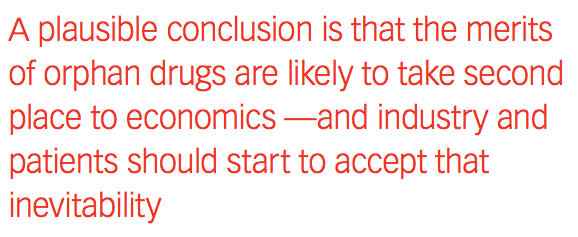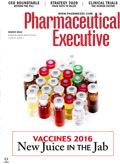Orphans of the Storm
Pharmaceutical Executive
Europe’s contrasting views on rare disease drugs - one bashing pricing abuses, the other extolling their public health virtues - could ultimately leave these products out in the cold.
In Europe, are we back in the territory of the right hand not knowing what the left hand is doing? A scathing attack on abuse of the orphan drug scheme from a leading European politician has coincided with the publication of an official European report enthusiastically extolling the virtues of the scheme, prompting renewed questions over how far the European Union (EU) is able to construct coherent health policies (view the report here).
Dueling tones
The criticism came from Dutch health minister Edith Schippers in an address to the Dutch parliament at the end of January, in which she lashed out at price demands that are “out of proportion to the costs of a drug.” She was particularly harsh on companies suspected of manipulating of the EU’s orphan drug rules. “There is unauthorized use,” she said, of instruments designed to foster innovation but that are being subverted to maximize company profits. The incentives the scheme offers go too far, she argued, threatening to “pursue a clearer definition of unmet medical need” and to raise questions about the intellectual property protection that industry enjoys-particularly the marketing exclusivity for orphans.
Schippers’ views matter, because she is currently the president of the EU’s health council, during the Netherlands’ turn in the rotating EU chair in the first half of this year. She is able to influence the agenda for health ministers’ discussions of policy-and drug pricing is right up at the top of the EU agenda at present.
Yet on almost the same day, the European Commission published a report on its orphan drugs scheme that took a very different tack. This was an inventory of the incentives to support research and development of orphans since the EU scheme was introduced in 2000, and it was prefaced by an extended salute to “impressive progress, in particular as regards to generating significant activity by the pharmaceutical industry.”
The report stated unambiguously that the development of orphan medicines is an important consideration for public health policymakers seeking to address patients’ needs, and its enumeration of the incentives available under the scheme carries no hint of reservation. It almost flaunts the establishment of an expert committee within the medicines agency, and the free protocol and regulatory assistance. It openly boasts of the 10 years of market exclusivity during which competitors are prevented from entering the market with a similar product. And it positively revels in the access the scheme provides to a centralized procedure allowing immediate marketing authorization in all member states.
Record to date
The outcome of the scheme to date is amply recorded with a full list of the dozens of authorizations granted so far-to say nothing of the lavish detail offered on the scheme’s popularity. Between 2000 and September 2015, the European Medicines Agency (EMA) received 2,302 applications for designation, and 1,544 designations were granted. Designation is an important step, because once granted, it gives a company access to many of the advantages of the scheme-and the attraction is enhanced by the fact that processing of an application for the designation incurs no fee for the company.
Not only can a company then seek advice from the EMA on how to progress its designated orphan (and this option is widely taken up; so far 951 protocol assistance procedures have been completed, of which 264 involved smaller firms), the organization is also better equipped to obtain public or private funding. Designation is a condition to receive funding from EU research programs, and also acts as an etiquette of respectability when approaching other sources of support.
The report lists 117 medicines authorized through the scheme to date-notably for pulmonary arterial hypertension, acute myeloid leukaemia, cystic fibrosis, multiple myeloma, and acute or chronic lymphoblastic leukaemia. It highlights cancer treatments such as Glivec (imatinib) for adult and paediatric chronic myeloid leukaemia, or Revlimid (lenalidomide) for adults with previously untreated multiple myeloma who are not eligible for transplants. And it flags up the importance of treatments for rare inborn errors of metabolism, such as Replagal (agalsidase alfa) or Fabrazyme (agalsidase beta) for confirmed Fabry disease, Vimizim (elosulfase alfa) for mucopolysaccharidosis, and blood disorder treatments such as Exjade (deferasirox) for chronic iron overload due to frequent blood transfusions in beta thalassaemia patients.
The report also makes clear the commission’s belief that the achievements so far, while useful, are far from sufficient. “The number of products authorized has grown over the years (which is encouraging for the future), but remains limited bearing in mind the 5,000 to 8,000 distinct rare diseases,” the report states. “We can conclude that just 1% of these are currently covered by authorized medicinal products in the EU. The incentives of the orphan drug legislation are, therefore, essential to facilitate pharmaceutical development.”
Firm backing
So the EU support for orphans continues. It organizes workshops to give companies guidance on key issues for designating and authorizing orphans, such as the determination of disease prevalence, significant benefit delivered by a treatment, and data collection methods and requirements. And because many companies apply for orphan designation in the EU at the same time as they apply for it elsewhere in the world, the EMA has developed international liaison on orphans with medicines agencies in North America and Japan, and holds a monthly teleconference with the FDA.
The EU also funds research on rare diseases and orphan drugs. More than $800 million was awarded to 120 research projects in this field during the seven-year research program that is just coming to a close. And under the new research program, Horizon 2020, the EU is committed to funding rare disease research at a comparable level.
Nowhere does the Commission report show any concern over abuse of the incentives offered by the scheme. It deals only in passing with issues of pricing and reimbursement, pointing out that under the Treaty, member states are responsible for the formulation of health policy and the organization and delivery of health services-including regulating the prices of medicines and their inclusion in health insurance schemes.
At only one point in the report does it acknowledge that there is an issue with reimbursement and orphans, and the approach it takes runs in the opposite direction to the Dutch health minister.
“The impact of reimbursement on the availability of orphan medicinal

products may be a matter of concern in the EU,” the report says.
But the concern from the Commission’s point of view is not that orphan drugs are overpriced, but that national limits on reimbursing them may impede patient access to them. “The budgetary impact of orphans is expected to rise due to the newly authorized products in the coming years,” states the report, without any hint that this should be a reason for cutting back on access to them.
Full embrace or false hope?
Which way will the argument over the orphan drug scheme go? Schippers is in charge of the EU health council only until the end of June, which is too short for any legislative action. But when push comes to shove, the member states have greater power than the Commission-certainly in pricing matters. And the concerns over high prices for monopoly suppliers, including of orphan drugs, continue to mount. A plausible conclusion is that the merits of orphan drugs are likely to take second place to economics-and industry and patients should start to accept that inevitability.
Reflector is Pharmaceutical Executive’s correspondent in Brussels

Addressing Disparities in Psoriasis Trials: Takeda's Strategies for Inclusivity in Clinical Research
April 14th 2025LaShell Robinson, Head of Global Feasibility and Trial Equity at Takeda, speaks about the company's strategies to engage patients in underrepresented populations in its phase III psoriasis trials.
Beyond the Prescription: Pharma's Role in Digital Health Conversations
April 1st 2025Join us for an insightful conversation with Jennifer Harakal, Head of Regulatory Affairs at Canopy Life Sciences, as we unpack the evolving intersection of social media and healthcare decisions. Discover how pharmaceutical companies can navigate regulatory challenges while meaningfully engaging with consumers in digital spaces. Jennifer shares expert strategies for responsible marketing, working with influencers, and creating educational content that bridges the gap between patients and healthcare providers. A must-listen for pharma marketers looking to build trust and compliance in today's social media landscape.